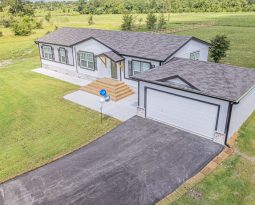MANUFACTURED HOMES CUSTOMIZED FOR THE HANDICAPPED MAY OFFER EXTERIOR AND INTERIOR MOBILITY
As today’s seniors’ age and more “baby boomers” retire, the need for quality, affordable and comfortable housing is paramount in the minds of many senior American citizens, especially those with mobility handicaps.
If you are lucky to live long enough, and many of us are, you may eventually lose some mobility requiring the utilization of a wheelchair for not only access to that home, but also the mobility to utilize and comfortably enjoy that home.
Today’s modern manufactured homes and modular homes are quality built with amenities, health and safety features equal or superior to comparable site-built homes, with prices up to 50% less per square feet of living space.
Many manufactured home and modular home builders may offer floor plans and customizable options that will address the particular requirements and desires of those with handicaps or may have mobility handicaps in the future.
To ensure that the quality of lifestyle and independence envisioned by the purchaser is maintained, you will want to select from an expansive choice of floor plan designs to determine what adjustments are available for addressing your existing or potential future handicap needs.
The following are suggestions and possibilities regarding interior mobility, followed by exterior accessibility.
FLOOR PLAN SUGGESTIONS FOR INTERIOR WHEELCHAIR MOBILITY
- An “open concept” floor plan layout with wheelchair access to every area of the home. Bedrooms should be separated and not confined to one area of the home, thus eliminating or minimizing hallways.
- Bathroom areas should be large and open, providing wheelchair radius access to the toilet, bath/shower, sink, and linen.
- Exit and passage doors should be unobstructed with a width of at least 36 inches.
- Countertop height can be conveniently adjusted according to the handicap needs of the homeowner. Kneehole access to counters may also be anticipated.
HANDICAPPED EXTERIOR ACCESS IS AN IMPORTANT POST-PRODUCTION CONSIDERATION
As we live longer, many will eventually lose the ability to climb stairs, requiring the necessity for wheelchair accessibility of entry and/or exit to the home. The appropriate time to address that is when you are contemplating the purchase of a new manufactured home and securing a reliable construction company to properly prepare your site to accommodate placement of the home with the home specifications you are considering to purchase.
Typically a manufactured home or modular home is installed approximately three feet above grade, necessitating steps at each entry and exit door. When a handicap ramp is used to displace the steps on a home, a 36-foot long ramp is required because each 12-foot horizontal length drops 12 inches, taking up a lot of space. Installing a handicap ramp of this size is only possible if the plot of land being used is large enough to accommodate.
The good news is that there are other alternatives to be considered that might better your situation if limited space is a consideration.
- Decrease the height of manufactured home: On a placement site that is near level, it is possible to install the home using shorter piers or blocks to a height from ground to about 16 inches, probably the lowest the home can be set above grade to allow for crawl space underneath home. This will require that the tires and axles be removed from the home chassis. At this height, you will be able to use a much shorter ramp. It may also allow you to create a ramp using concrete to a porch landing.
- In-Ground Low Profile Installation: Excavating a site (where permitted) to allow manufactured home or modular home to be installed with door entries to at ground level is becoming very popular with many home purchasers. This installation method eliminates the need for stairs and does not require the use of skirting (aka. underpinning) around the exterior of the home as the perimeter blocking or foundation is below ground level of home. The low profile of the home makes it appear more residential than a manufactured home installed in the conventional manner. This type of installation goes by various names, such as; pit-set, low profile, or a low silhouette installation.
- Residential Wheelchair Lifts: Residential lifts are less expensive, adapt to high entries, can be used by residents/visitors and their footprint is minimal. Some manufacturers or post-production installers may be able to incorporate “lift ready” applications into the manufactured home front entry porches. The only drawback to lifts, they won’t work in an emergency during a power outage.
Whether you or a family member are handicapped, and/or might be in the future, you will find that a high quality manufactured home can be built efficiently and installed to your specific and personal needs and desires.
Shoppers are invited to review thousands of floor plans and models produced by manufactured home and modular home producers from across the U.S., and for sale by authorized retailers here at ManufacturedHomes.com Feel free to experience 3D virtual tours of selected models and review construction specifications. Simply type-Your town- in the search bar to locate a retailer near you. Securing a no-obligation price quote is easy as clicking “GET CUSTOM PRICE QUOTE” on any of the displayed floor plans.







